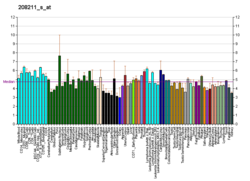Kinase du lymphome anaplasique

Pour les articles homonymes, voir ALK.
| ALK | |||||||||||||||||||||||||||||||||||||||||||||||||||
|---|---|---|---|---|---|---|---|---|---|---|---|---|---|---|---|---|---|---|---|---|---|---|---|---|---|---|---|---|---|---|---|---|---|---|---|---|---|---|---|---|---|---|---|---|---|---|---|---|---|---|---|
 | |||||||||||||||||||||||||||||||||||||||||||||||||||
| |||||||||||||||||||||||||||||||||||||||||||||||||||
| Identifiants | |||||||||||||||||||||||||||||||||||||||||||||||||||
| Aliases | ALK, kinase du lymphome anaplasique | ||||||||||||||||||||||||||||||||||||||||||||||||||
| IDs externes | OMIM: 105590 MGI: 103305 HomoloGene: 68387 GeneCards: ALK | ||||||||||||||||||||||||||||||||||||||||||||||||||
| |||||||||||||||||||||||||||||||||||||||||||||||||||
| |||||||||||||||||||||||||||||||||||||||||||||||||||
| |||||||||||||||||||||||||||||||||||||||||||||||||||
| |||||||||||||||||||||||||||||||||||||||||||||||||||
| |||||||||||||||||||||||||||||||||||||||||||||||||||
| Wikidata | |||||||||||||||||||||||||||||||||||||||||||||||||||
| |||||||||||||||||||||||||||||||||||||||||||||||||||
La kinase du lymphome anaplasique (ou ALK pour anaplastic lymphoma kinase) est une tyrosine kinase. Son gène dit ALK est situé sur le chromosome 2 humain. Elle appartient à la superfamille des récepteurs de l'insuline partageant un degré élevé d'homologie avec la tyrosine kinase leucocytaire[5].
En médecine
Elle est impliquée dans plusieurs cancers.
Certains cancers pulmonaires comportent une fusion de l'ALK avec l'EML4 (« echinoderm microtubule-associated protein-like4 »)[6]. C'est le cas notamment d'environ 5 % des adénocarcinomes pulmonaires, ces derniers comportant certaines caractéristiques cliniques[7] : sujets plus jeunes, non fumeurs.
Cible thérapeutique
Le crizotinib est un inhibiteur de l'ALK qui s'avère efficace dans le traitement des cancers du poumon impliquant la fusion EML4-ALK[8]. D'autres molécules ciblant cette même enzyme, sont en cours de développement ou déjà commercialisés : le ceritinib[9], l'alectinib, le brigatinib, le lorlatinib.
Notes et références
- ↑ a b et c GRCh38: Ensembl release 89: ENSG00000171094 - Ensembl, May 2017
- ↑ a b et c GRCm38: Ensembl release 89: ENSMUSG00000055471 - Ensembl, May 2017
- ↑ « Publications PubMed pour l'Homme », sur National Center for Biotechnology Information, U.S. National Library of Medicine
- ↑ « Publications PubMed pour la Souris », sur National Center for Biotechnology Information, U.S. National Library of Medicine
- ↑ Mark A. Lemmon et Joseph Schlessinger, « Cell Signaling by Receptor Tyrosine Kinases », Cell, vol. 141, no 7, , p. 1117–1134 (ISSN 0092-8674, PMID 20602996, PMCID PMC2914105, DOI 10.1016/j.cell.2010.06.011, lire en ligne, consulté le )
- ↑ Inamura K, Takeuchi K, Togashi Y et al. EML4-ALK fusion is linked to histological characteristics in a subset of lung cancers, J Thorac Oncol, 2008;3:13-17
- ↑ Rodig SJ, Mino-Kenudson M, Dacic S et al. Unique clinicopathologic features characterize ALK-rearranged lung adenocarcinoma in the western population, Clin Cancer Res, 2009;15:5216-5223
- ↑ Shaw AT, Kim DW, Nakagawa K et al. Crizotinib versus chemotherapy in advanced ALK-positive lung cancer, N Engl J Med, 2013;368:2385-2394
- ↑ Marsilje TH, Pei W, Chen B et al. Synthesis, structure-activity relationships and in vivo efficacy of the novel potent and selective anaplastic lymphoma kinase (ALK) inhibitor LDK378 currently in phase 1 and 2 clinical trials, J Med Chem, 2013;56:5675-5690
 Portail de la médecine
Portail de la médecine  Portail de la biologie cellulaire et moléculaire
Portail de la biologie cellulaire et moléculaire





















